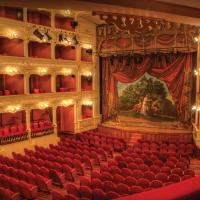Mozart wrote Die Zauberflöte in 1791 and it was first performed two months before his death. In Paris two years earlier the revolutionaries had stormed the Bastille, while in Mozart’s Vienna the talk concerned the possible restoration of the French monarchy as an unsettled populace wondered about its own country’s future.
The libretto was written by the impresario Emanuel Schikaneder and based on a book of Oriental fairytales. Schikaneder, like Mozart, was a Freemason but not as deeply involved; both men’s work was influenced by their solemn Masonic beliefs. Mozart was indebted to the Freemasons from whom he had borrowed money on occasions.
The quasi-religious-comic theme of the opera is at the root of its almost pantomime complexity of an amusing and confusing Oriental fantasy written in the popular dramatic style known as Singspiel (literally ‘sing-play’). This German blend of sung and spoken text was used by Mozart elsewhere and also by Beethoven in Fidelio. Mozart’s Viennese version of Singspiel was more operatic in nature and very suitable for the fairytale plot of Zauberflöte.
Early in the opera Prince Tamino is rescued from a serpent and receives a portrait of the beautiful Pamina, daughter of the Queen of the Night. Accompanied by Papageno the bird-catcher, Tamino immediately determines to seek out Pamina. The Queen of the Night tells him that her daughter is in the power of Sarastro, High Priest of the Egyptian gods Isis and Osiris, and that Tamino must rescue her. He is provided with a magic flute to keep him from harm, while Papageno is given a chime of magic bells.
Tamino learns that Sarastro is really a wise priest in disguise and that the Queen of the Night is the evil character. Pamina and Papageno are told to use his magic bells to bewitch their captors and make their own escape.
In Act Two, the priests give Sarastro their permission to initiate Tamino into the Brotherhood so that he can receive the spirit of wisdom. However, there are trials he must undergo before he can enter the Temple of Light. Papageno wishes more simply for a love of his own.
His desire is granted by an old crone who magically turns into Papagena, a beautiful girl who immediately vanishes. Meanwhile Pamina and Tamino pass together through trials of fire and water protected by the magic flute. Eventually Papageno is reminded to use the magic bells and Papagena returns to
become his wife.
Under cover of darkness the Queen of the Night and her attendants storm the Temple and take their revenge. As dawn breaks, Sarastro captures them and casts them into eternal darkness. Once the forces of evil have been driven away, the newly initiated are welcomed and a hymn of thanks and praise is sung to the gods by the Priests of Osiris.
Composer: Mozart Wiki Link: https://en.wikipedia.org/wiki/The_Magic_Flute Title of Musical Work: Die Zauberflöte (The Magic Flute) (Excerpts)